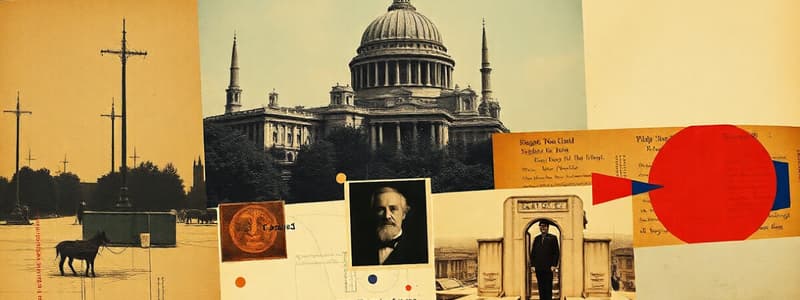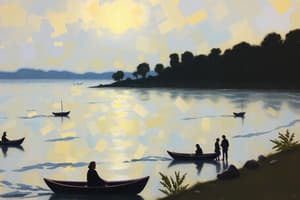Podcast
Questions and Answers
Which of the following is NOT considered a primary source?
Which of the following is NOT considered a primary source?
- A photograph of a historical event
- A diary entry from a person who lived through a historical event
- A painting by a historical artist
- A documentary about a historical event (correct)
What is the primary function of the National Archives of the Philippines?
What is the primary function of the National Archives of the Philippines?
- To provide access to and preserve historical documents related to the Philippine Revolution and the establishment of the Republic
- To preserve and protect the historical legacy of the Philippines, including documents dating back to Spanish rule (correct)
- To preserve the intellectual heritage and cultural history of the Philippines through books and other published materials
- To research and analyze primary sources relating to the Philippines' history and culture
A literature review that cites an empirical study would be considered a ______ source.
A literature review that cites an empirical study would be considered a ______ source.
- Primary
- Tertiary
- Secondary (correct)
- Quaternary
Which of the following would be most useful for understanding the context of a historical event?
Which of the following would be most useful for understanding the context of a historical event?
What is a primary requirement of the Positivism method of criticism?
What is a primary requirement of the Positivism method of criticism?
Which challenge do post-colonial nations typically face after gaining independence?
Which challenge do post-colonial nations typically face after gaining independence?
What does the Annales School of Thought primarily reject in historical analysis?
What does the Annales School of Thought primarily reject in historical analysis?
What is a key aspect of Pantayong Pananaw in historical criticism?
What is a key aspect of Pantayong Pananaw in historical criticism?
Which of the following best describes the focus of post-colonial studies?
Which of the following best describes the focus of post-colonial studies?
Which of the following is considered a primary source in the field of history?
Which of the following is considered a primary source in the field of history?
Which of the following best describes a secondary source?
Which of the following best describes a secondary source?
What type of primary source would a recorded speech fall under in communication studies?
What type of primary source would a recorded speech fall under in communication studies?
Which of these is NOT a primary source in the field of art and literature?
Which of these is NOT a primary source in the field of art and literature?
In law and politics, which of the following would be classified as a primary source?
In law and politics, which of the following would be classified as a primary source?
Which of the following could be considered a secondary source?
Which of the following could be considered a secondary source?
What is the primary purpose of a secondary source?
What is the primary purpose of a secondary source?
Which of the following is NOT considered a primary source in social studies?
Which of the following is NOT considered a primary source in social studies?
Flashcards
Positivism
Positivism
A method requiring written primary documents to validate historical claims.
Post Colonialism
Post Colonialism
A study of how formerly colonized nations establish cultural identity post-independence.
Annales School of Thought
Annales School of Thought
A historical approach emphasizing everyday life over politics and monarchs.
Cultural Identity
Cultural Identity
Signup and view all the flashcards
Pantayong Pananaw
Pantayong Pananaw
Signup and view all the flashcards
Primary Sources
Primary Sources
Signup and view all the flashcards
Examples of Primary Sources in History
Examples of Primary Sources in History
Signup and view all the flashcards
Primary Sources in Art and Literature
Primary Sources in Art and Literature
Signup and view all the flashcards
Primary Sources in Communication Studies
Primary Sources in Communication Studies
Signup and view all the flashcards
Secondary Sources
Secondary Sources
Signup and view all the flashcards
Examples of Secondary Sources
Examples of Secondary Sources
Signup and view all the flashcards
Citing Secondary Sources
Citing Secondary Sources
Signup and view all the flashcards
Evaluative Secondary Sources
Evaluative Secondary Sources
Signup and view all the flashcards
National Archives of the Philippines
National Archives of the Philippines
Signup and view all the flashcards
National Library of the Philippines
National Library of the Philippines
Signup and view all the flashcards
National Historical Commission of the Philippines
National Historical Commission of the Philippines
Signup and view all the flashcards
Study Notes
Methods of Historical Criticism
-
Positivism: Requires written primary documents; no document, no history.
-
Post Colonialism: A 20th-century movement focused on how colonized nations established their culture and identity after independence, acknowledging lasting colonial effects.
-
Annales School of Thought: Focuses on broader historical contexts beyond just state and monarch figures.
-
Pantayong Pananaw: Emphasizes internal Filipino discussions and interpretations of history.
Primary and Secondary Sources
-
Primary Sources: Original materials directly connected to events. Examples include letters, diaries, photographs, official documents, physical objects (e.g., paintings), novels, poems, interview transcripts, recordings of speeches, newspapers, magazines, legal texts, and statistical data.
-
Secondary Sources: Interpretations or analyses of primary sources. Examples include books, articles, documentaries, summaries, encyclopedias, reviews, and essays.
Distinguishing Primary from Secondary Sources
-
Primary: Direct accounts, original information, created by participants in events. Examples include a novel, a painting, photographs from a historical event, or an empirical study.
-
Secondary: Analyses or interpretations of primary sources. Examples include articles about a novel, catalogs explaining a painting, documentaries about an historical event, or a literature review referencing a study.
Repositories of Primary Sources
-
National Archives of the Philippines: Houses millions of Spanish-era and Republic-era documents.
-
National Library of the Philippines: Preserves printed and recorded cultural and historical materials.
-
National Historical Commission of the Philippines: Responsible for conserving and preserving the country's historical heritage.
-
National Museum of the Philippines: Acquires, documents, preserves, exhibits, and promotes research on Filipino cultural heritage and natural history.
Studying That Suits You
Use AI to generate personalized quizzes and flashcards to suit your learning preferences.



